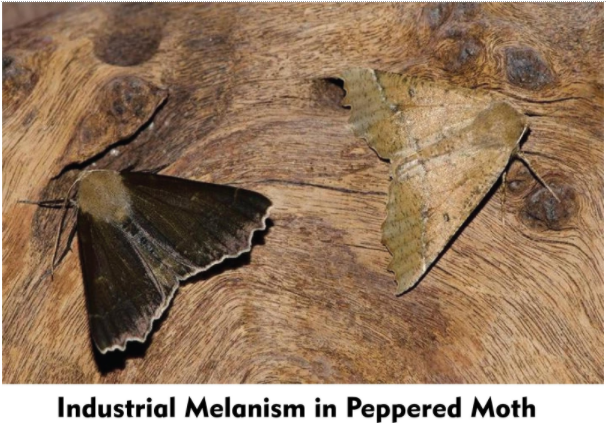
Explain industrial melanism.
Answer
483.9k+ views
Hint: - Melanism is the property of having darker features like feathers, fur, or skin. Industrial melanism refers to the darkening of these features due to the influence of industries due to their activities and the substances released from them.
Complete answer:
- Industrial melanism is a feature acquired by species living in a particular area where the environment is subjected to industrial pollution, where the creature becomes darkened in the case of their feathers, fur, or skin. This has been particularly noticed in some arthropods. The feature acquired helps in camouflaging the species from their predators.
- In an environment where the species gain a darker color due to the pollution, their lighter counterparts are subject to predation. The darker species gain camouflage by blending into dark surfaces like tree barks and pollutant-covered walls.
- The most important example of this phenomenon is the melanism observed by Kettlewell in the peppered moth (Biston betularia), during the Industrial Revolution. Kettlewell observed that white-colored peppered moths inhabited tree barks of various places in England during the 1800s. The dark or melanic forms were the rare mutants and could not camouflage well in the lichen on the tree barks, thus being a target for predators. But as the pollution due to the increase in industries increased, the pollutants like sulfur dioxide got deposited on surfaces of the surrounding trees, giving the barks a darker color. This would lead to the predation of the white-colored moths. Thus, in the next generations, more melanic moths were observed which could camouflage in the darker surfaces and be protected from being eaten.
- In the 1970s after the reduction of pollution, white-colored moths reappeared, proving that the change in color is in response to the surroundings.
- The phenomenon is thus a process of natural selection.
Additional Information:
- Industrial melanism is also observed in other species, mostly lepidopterans.
- The phenomenon has been observed for adaptation to other processes such as thermal advantages, immunity, etc.

Note: - Industrial melanism is observed in around 70 species of moths, some species of beetles, and pigeons.
- The peppered moth is a species of the nocturnal moth. The caterpillar of these moths is also well equipped to display mimicry of plant twigs.
Complete answer:
- Industrial melanism is a feature acquired by species living in a particular area where the environment is subjected to industrial pollution, where the creature becomes darkened in the case of their feathers, fur, or skin. This has been particularly noticed in some arthropods. The feature acquired helps in camouflaging the species from their predators.
- In an environment where the species gain a darker color due to the pollution, their lighter counterparts are subject to predation. The darker species gain camouflage by blending into dark surfaces like tree barks and pollutant-covered walls.
- The most important example of this phenomenon is the melanism observed by Kettlewell in the peppered moth (Biston betularia), during the Industrial Revolution. Kettlewell observed that white-colored peppered moths inhabited tree barks of various places in England during the 1800s. The dark or melanic forms were the rare mutants and could not camouflage well in the lichen on the tree barks, thus being a target for predators. But as the pollution due to the increase in industries increased, the pollutants like sulfur dioxide got deposited on surfaces of the surrounding trees, giving the barks a darker color. This would lead to the predation of the white-colored moths. Thus, in the next generations, more melanic moths were observed which could camouflage in the darker surfaces and be protected from being eaten.
- In the 1970s after the reduction of pollution, white-colored moths reappeared, proving that the change in color is in response to the surroundings.
- The phenomenon is thus a process of natural selection.
Additional Information:
- Industrial melanism is also observed in other species, mostly lepidopterans.
- The phenomenon has been observed for adaptation to other processes such as thermal advantages, immunity, etc.

Note: - Industrial melanism is observed in around 70 species of moths, some species of beetles, and pigeons.
- The peppered moth is a species of the nocturnal moth. The caterpillar of these moths is also well equipped to display mimicry of plant twigs.
Recently Updated Pages
Master Class 10 Science: Engaging Questions & Answers for Success

Master Class 10 Social Science: Engaging Questions & Answers for Success

Master Class 10 Maths: Engaging Questions & Answers for Success

Master Class 10 English: Engaging Questions & Answers for Success

Class 10 Question and Answer - Your Ultimate Solutions Guide

Master Class 9 General Knowledge: Engaging Questions & Answers for Success

Trending doubts
A boat goes 24 km upstream and 28 km downstream in class 10 maths CBSE

Why is there a time difference of about 5 hours between class 10 social science CBSE

The British separated Burma Myanmar from India in 1935 class 10 social science CBSE

The Equation xxx + 2 is Satisfied when x is Equal to Class 10 Maths

Chandigarh is the capital of A Punjab B Haryana C Punjab class 10 social science CBSE

What are the public facilities provided by the government? Also explain each facility




